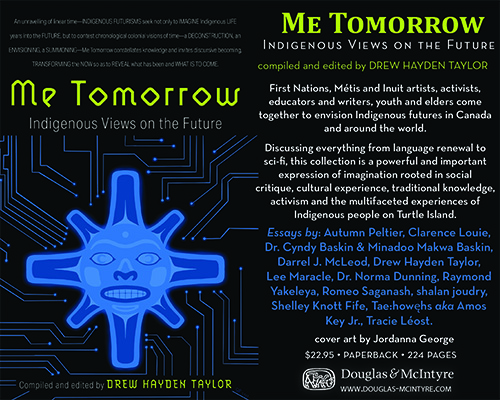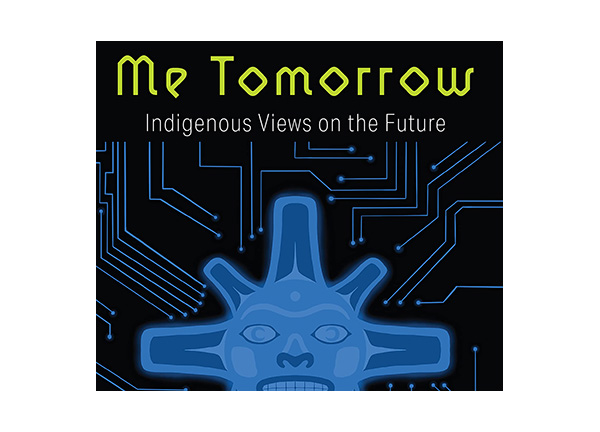Reviewed by Rob Houle, Local Journalism Initiative Reporter
(ANNews) – Beginning with first glance at the cover of Me Tomorrow: Indigenous Views of the Future, the latest anthology compiled and edited by Anishinaabe writer Drew Hayden Taylor, readers cannot help but be pulled forward in time. The cover piece, titled “Motherboard,” marries First Nations coastal art with computer circuitry, foreshadowing the overall theme of the book. By bringing two seemingly disconnected worlds together, Indigenous and non-Indigenous, past and future, old and new, artist Jordanna George and the numerous authors approach the prospect of Indigenous futures in a myriad of ways.
 Ranging from the overly optimistic to the painfully blunt, pieces from First Nations, Metis and Inuit writers, leaders and knowledge holders provide examples of how diverse our collective future could be. Building upon each contributor’s background, upbringing, trauma and accomplishments, Me Tomorrow gives readers a broad sense of what the Indigenous experience has been in Canada and Indigenous communities. The writings make an important point, although not obviously, that these two worlds exist separately in what we now know as Canada.
Ranging from the overly optimistic to the painfully blunt, pieces from First Nations, Metis and Inuit writers, leaders and knowledge holders provide examples of how diverse our collective future could be. Building upon each contributor’s background, upbringing, trauma and accomplishments, Me Tomorrow gives readers a broad sense of what the Indigenous experience has been in Canada and Indigenous communities. The writings make an important point, although not obviously, that these two worlds exist separately in what we now know as Canada.
And ultimately, that our shared future and prosperity relies on this separation becoming less glaring.
Approaching the future in 20 to 50 year increments, pieces by Darrel J. McLeod, Minadoo Makwa Baskin and Dr. Cindy Baskin, and Autumn Peltier examine individual futures based upon an upward trajectory. Utilizing the progress made on climate issues, court victories and international arenas as a jumping off point, each author envisions a future in which our communities only continue to grow and “sur-thrive.” For each piece, there exists the theme of growing as communities and people by returning to the past. An interpretation of Indigenous belief that time is not a linear function, but circular, and to continue moving forward we must return to traditional teachings and understandings.
Reflected most clearly by Dr. Cindy Baskin in the following excerpt:
“Thus, within educational institutions, non-Indigenous students will develop an awareness that Indigenous People have been living on our planet for thousands of years and they managed not only to survive but to live on and with the land, learned or developed technologies to help themselves, and cultivated their own values and laws.”
With eyes focused on the future, other contributors take the approach that more work in the present, within our communities, is required before we can achieve Me Tomorrow. Chief Clarence Louie, of the Osoyoos Band, provides a blunt examination of the work required in Indian Country, or as he states the “Rez.”
In the chapter Seven Generations Thinking-Fact or Fiction? Chief Louie provides readers with hard hitting truths about how wayward our leadership models have fallen, and how we as Indigenous communities can get things back on track. By emphasizing our diligent and hard-working nature pre-Contact with where we are today, Chief Louie highlights how out of sync we have become with traditional ways of life. He makes the point clearly:
“Before the English and the French came into our territories and forced our people onto Indian reserves, we were self-supporting people. Natives worked hard for a living, every day of every year. Think about it: it was hard work to provide food, clothing and shelter for a family when there were no grocery stores, no electricity, no clothing stores.”
Contrasting this with the current reality of unemployment rates as high as thirty percent and a reliance on social assistance programs, Chief Louie stresses that we must deal with present issues before looking forward to the next seven generations. And if we do not address our own internal Rez problems, then Me Tomorrow may look shockingly similar to present day circumstances.
In alignment with needing to emphasize current issues and address them as we move forward, former Member of Parliament Romeo Saganash provides his insightful piece, No Reconciliation in the Absence of Truth and Justice, on his experiences with government and the path we are currently on. By sharing personal and passionate stories about his time in government, and his clashes with the current Prime Minister (including the famous House of Commons eff bomb), Saganash outlines just how far Canadians have to go as well. Recognizing that Me Tomorrow is not something that can happen in a silo, but rather that our two worlds are connected, Saganash calls on Canada and Canadians to do more.
This unique place we have arrived at together over the last 450+ years is foundational to the forward thinking of Me Tomorrow. These difficult truths and realities serve as a base upon which Indigenous people and Canadians must build upon to realize a more prosperous future. This is most succinctly captured at the close of Romeo Saganash’s entry when he writes:
“It seems a simple place to start, but this new adventure has the potential to take us to that elusive moment in our lives when we realize that the unexpected “second chance” has come…”
Overall, Me Tomorrow: Indigenous Views on the Future, published this month by Douglas & McIntyre, is an intriguing journey between the past, present and future through Indigenous truths. These truths, sometimes difficult to accept, serve to open the readers eyes and allow them to imagine an infinite possibility of futures. Futures possible as long as we can solve the ills of the past.



Be the first to comment on "Drew Hayden Taylor presents Indigenous Views of the Future with new title “Me Tomorrow”"